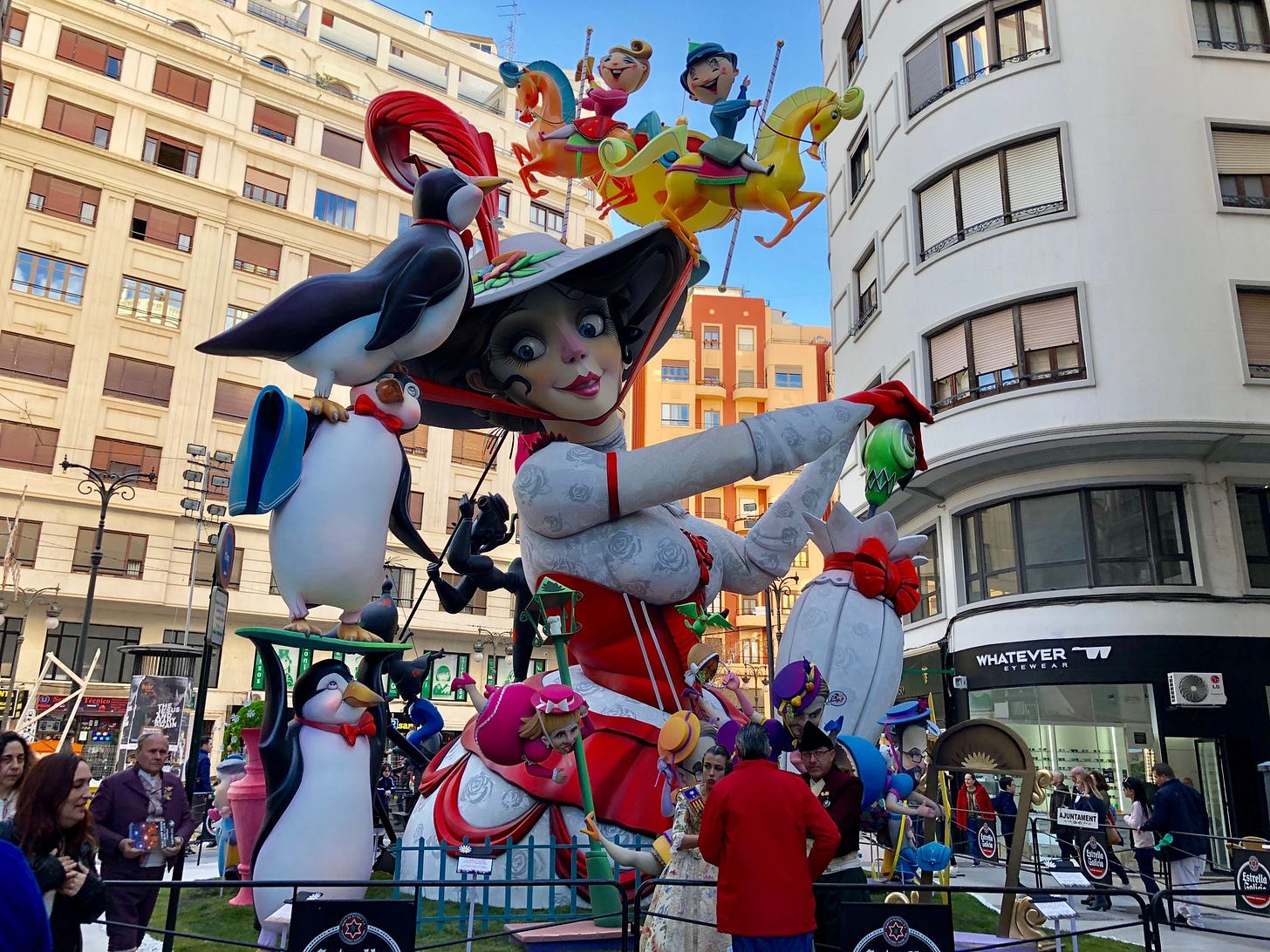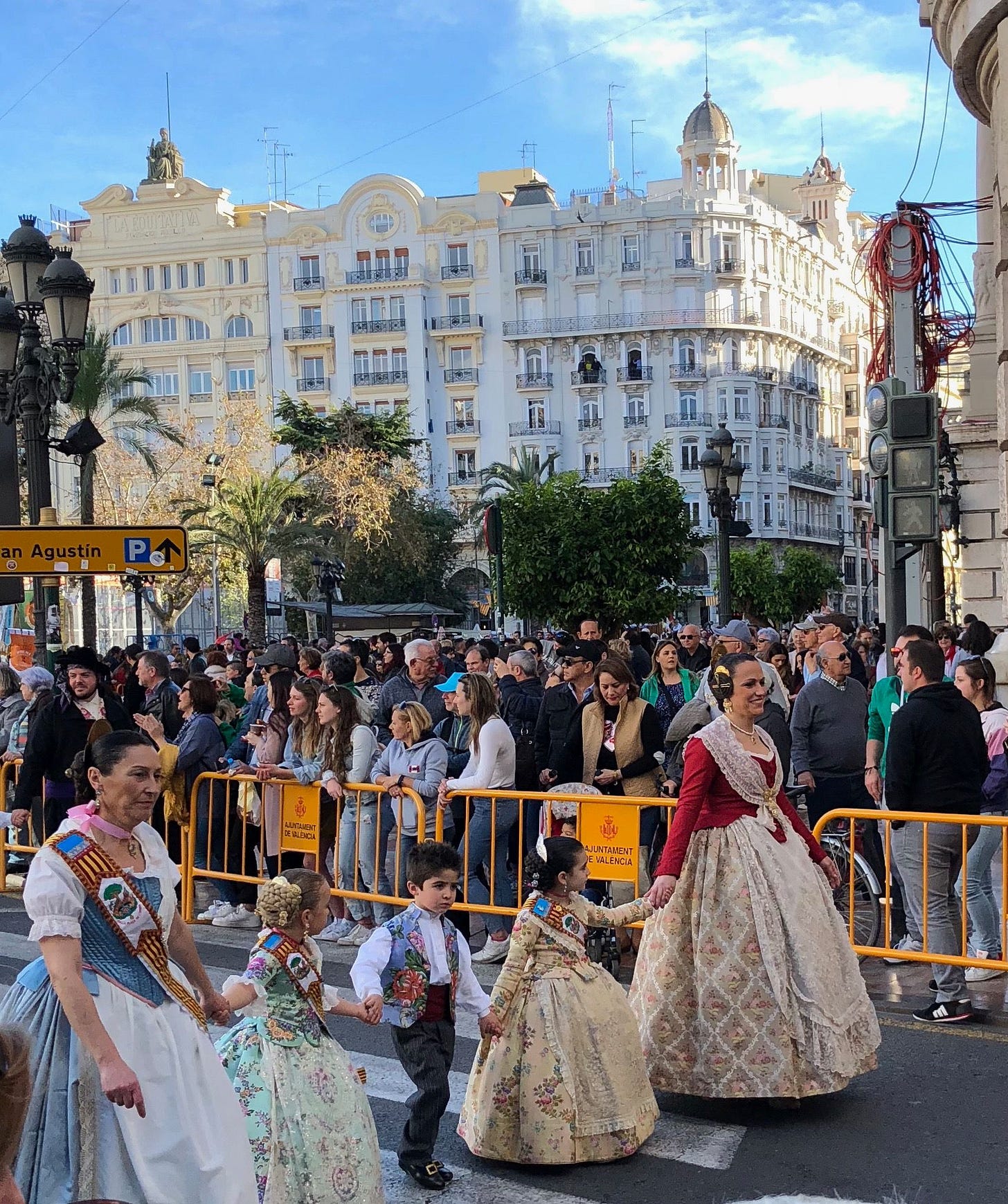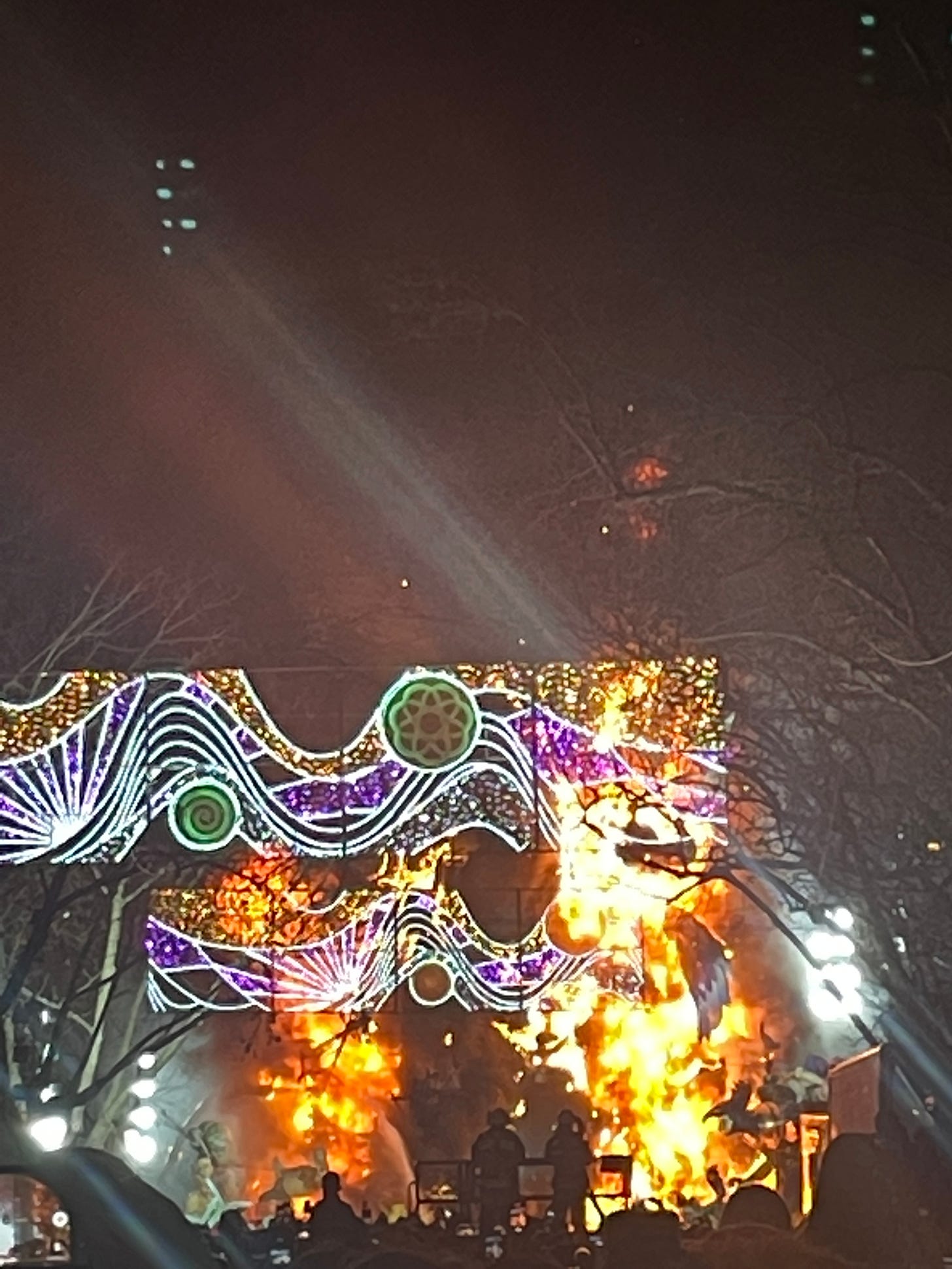Valencia en Fallas: A Walkthrough to Valencia's Biggest Festival
Or thoughts on a 19-day, knock-down, drag-out affair that has the best and worst of us in it.
The signs start to emerge in mid-February. Cherry picker cranes park on sidewalks so workers can hang wires to run above streets. Women wearing classic dresses, with Danish shaped braids covering their ears, pop up in more and more photos on Instagram and in newspapers. Food trucks take the place of the cherry picker cranes on the sidewalk, setting up shop to sell buñuelos and churros. A relative quiet persists at night. The storm, though, is coming. It is Fallas season.
Las Fallas is Valencia’s holiday, the event Valencia is best known for, and Fallas is much more. A way of life. An organizing principle to an annual calendar. A 19-day endurance test, a battle of sonic attrition. A badge of pride or a reason to get out of town. It’s one of the things best known about Valencia, and even then, something poorly understood.
This will be our 5th run through a full Fallas. I am still learning much about the festival. But as it kicks off tomorrow, and given recent events, I thought it opportune to review Fallas.
The real fire festival
“Falla” means torch. Fallas is in many ways the holiday of fire. Falla, in the day-to-day context of the celebration, can have multiple meanings, but most events come back to fire and explosions. When we refer to Fallas as a holiday, we are referring to a celebration running from March 1st to March 19th, crescendoing in the last four days. The 19th is Father’s day in Spain, but that feels to most moderners like a coincidence1; it is also the dia de San Jose, Saint Joseph’s day, the actual holiday celebrated.
But the holiday is an aside, an excuse, a Macguffin to set this week-long festival into action. Catholicism is imbued into the celebration, but it’s quite possible Fallas’s origins were pagan, and most of the glee glows agnostic. The final burning comes days before the Spring Solstice, with its promise of renewal. Spain’s Catholics have a, well, history of public burnings, but the general idea has roots in more ancient instincts.
There is a pace to a Fallas calendar, a steadily building drumbeat. In one sense, Fallas runs all year. One meaning of Falla is the neighborhood association that hosts barbecues and parties through the year, with the Fallas holiday as its culmination. The city-wide Fallas councils –Fallas is an event in Valencia and the Valencian region – will have preliminary events; selections of the fallera mayor for example, the belle of the Fallas ball. There is a Fallera mayor and Fallera mayor infantil, or a child Fallera mayor, for the city and for every Falla that has enough people.
The falleros and falleras are members of the neighborhood fallas, the actual participants in the festivities. They dress in old-fashioned outfits – it is offensive to call them disfraces, or costumes. The woman wear embroidered dresses with big hoop skirts and fashion their hair in Princess Leia style buns2. The men wear bandanas and short pants with tights and a cost…er, outfit looks like pirate wear. People dress this way more and more over the course of March, but it’s not so rare to see small groups of falleros or individual women dressed up throughout the year.
“Les Fallas son por los falleros,” the assistant at my dentist’s office tells me, explaining why she likes it even as she knows many don’t. I would say Fallas is for the falleros, but also for tourists. The last two years, with Fallas ‘back3’ from the pandemic and March 19th falling on a Saturday and then a Sunday, Valencia thronged with visitors. The sort of massive foot traffic around the key sites that gives one claustrophobia, that strikes one as dangerous, has become a regular feature of Fallas.
Most Valencians who are not falleros leave town for the last few days. Amy will be going away for the second year in a row. Me, I’m as local as anyone, I’m just a sap for most of this stuff.
Fallas’ bone-rattling beats
Let’s go back to that calendar and break down what actually happens in Fallas. A few themes will emerge.
We start with La Crida, the call. This is the ‘starting gun’ of Fallas. On the last Sunday of February4, there are a series of fireworks lightings, first in the morning (la despertá, the wake-up), then at 2pm (la mascletà, a midday fireworks display), and then at 7pm (la crida itself). As you might guess, only this last one is a primarily visual fireworks display, set off against the backdrop of the Torres de Serrano, the iconic of two pairs of watchtower gates leading into the old city.
The first week of March features daily mascletàs. The mascletà is in some ways the most universal, most social, most egalitarian part of Fallas. It happens at 2pm, the start of the lunch hour in Spain. Valencians will meet with colleagues, or impress clients, or invite out of town guests to the Plaza del Ayuntamiento, the central town hall square, to watch and listen, whether at street level or quasi-exclusive clubs looking over the square from the 8th floor. As the crowds pack in, a warning shot will go off at 1:50 and again at 1:55pm. Then at 2, the day’s master of ceremony – each day can feature a different fireworks technician – will start the show.
It's March. The sun is still high in the sky, and there is no shadow for the fireworks to shoot off against. The mascletà is not to be seen, it is to be heard and felt. Each show is a 5-10 minute set, an escalating explosion of sound and vibration, each one picking up to a frenetic, heart-pulsing finish. And then the town hall plays classic Fallas songs on the speaker system and thousands of people disperse. It is wild.
The mascletà is the main event of the first 10 days or so of Fallas. On the first weekend, there are usually paella parties – the acceptable exception to the rule that one only eats paella for lunch – and food trucks out in the streets of Ruzafa, the hip, narrow street part of town. There might be late night outdoor parties, and there are intraFallas parties that we outsiders aren’t part of, but that’s the bulk of it.
Fallas’s villains – almost everyone, with a match in hand
There are, however, the petardos. The word translates as firecracker, and these are firecrackers, but imagine it as a category rather than a specific product. These petardos range from sets of 10-12 fizzling pops to more industrial size booms, explosions that mimic gunshots.
Each year, the first week of Fallas is a re-acclimation into the simulated war zone of a Fallas street. Petardos are the villain of Fallas for all but the native Valencians and falleros. No schedule governs the use of petardos during Fallas, and there is only the barest sense of common decency.
During my first Fallas, I biked by a father and child playing in a road-side dirtbed. “How cute, maybe they’re looking at ants or insects or talking about science,” I thought as I biked by. A second later, BOOM, and then cackles.
While the primary petardo culprits are pre-teen boys, lighting things that go boom a joy that spans the generations in Valencia. Last year, I dropped what my high school friends called the “flying dolphin” pose, extending my arms out with palms to the sky in exasperation, on a 60-year-old woman as she and her group moseyed from one side of the road to the sidewalk and back to the other side, lighting petardos all the way and imperiling my evening. “Perdona, dejamos que el señor pase5,” she rasped at her group and me in what I hope was friendly mockery.
I later saw an abuela giggling in delight as she skittered away from a lit mini bomb. Most characteristic may have been a man of 70 or so on the edge of our neighborhood square racing to set off a machine gun like cracker, only for it to sputter out four pops before failing. He almost got more joy from the defeat.
These petardos menace our human enjoyment of Fallas, and are that much worse for animals. Dogs are especially jittery during fireworks, and I don’t quite understand what birds do for these three weeks. Our cats mostly acclimate after the first week – it helps that people in Valencia, which fancies itself as the fireworks capital of the world, will stage random firework celebrations throughout the year – though they get tired of it by the end of Fallas. Also, our cats are built different.
If one could ban petardos from Fallas, or at least restrict their usage, and one could limit the crowds, Fallas would be a wonderful festival. Those two woes compound each other towards the end, though: each free space from crowds is a mixed blessing. On the one hand, one can walk. On the other hand, free spaces are prime spots to light petardos. Each time I entered into a free space last year, I would forget that, only to snap into reality. The only variable was whether I snapped myself or whether an explosion did.
Building out the Fallas holiday
At the midpoint of Fallas, the schedule thickens. Fallas in Ruzafa and Malvarossa, a beach neighborhood, hang ornate streetlight decorations6. A citywide parade or two marches, and Fallas stage their own local parades and processions. My favorite part of Fallas – 10-12 piece marching bands – emerges at about this point7. Featuring brass, percussion, and reedy dulzainas, these groups play Fallas classics and pop songs. Last year, Rosalia’s “Despecha” was the most popular cover in my unscientific observation, with perennial favorites “Mari Carmen” and “Despacito” tied for second. These bands make Fallas a perennial daytime street party.
The midpoint is also when we start to see signs of the Fallas sculptures. Also called Fallas, these are sculptures of cardboard, papier-mâché, cork, and other materials. Each of the neighborhood association Fallas are tiered into different groups, from the special competition down to category 8C. Each neighborhood Falla funds the building of a sculpture Falla of corresponding size. Our neighborhood’s Falla is in 8B or 8C, and the sculpture is usually 10-15 feet tall, with a base of 8x8 feet. The biggest Fallas are the size of a mansion, climbing as high 40-50 feet. Each tier features a competition, and the official Fallas committee selects the winners. There is also a Falla in the town hall square that goes 6 stories high or so.
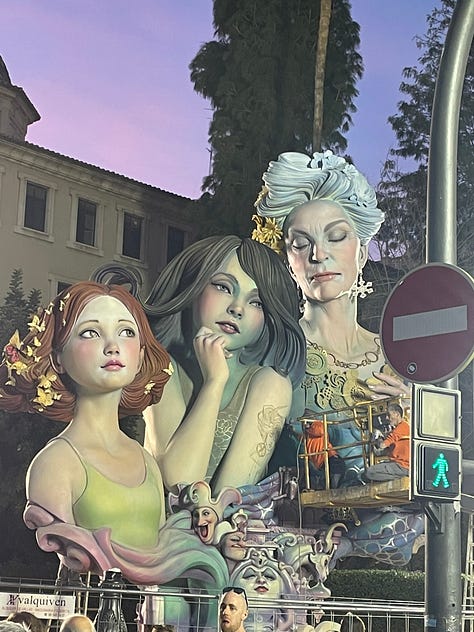
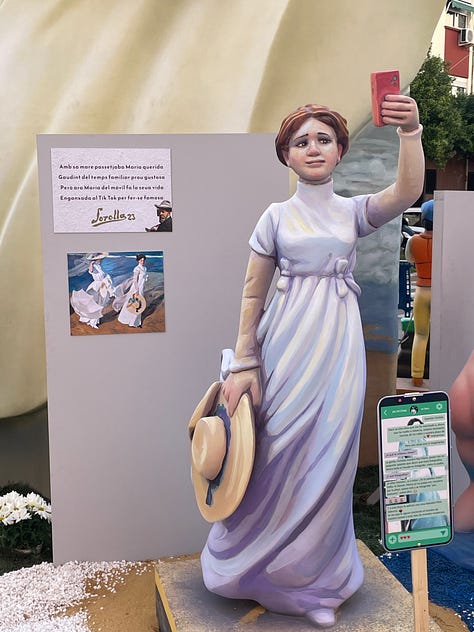
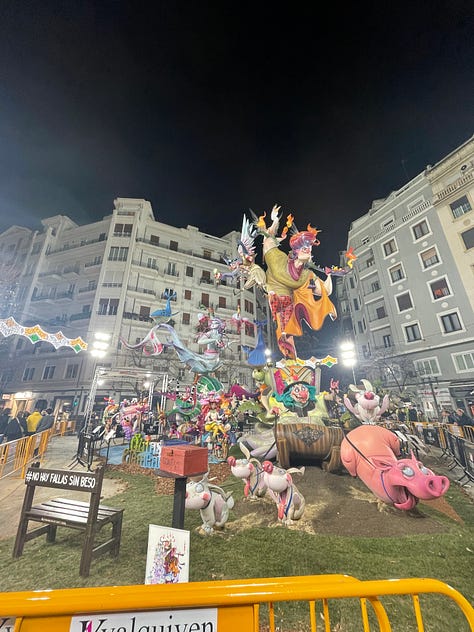
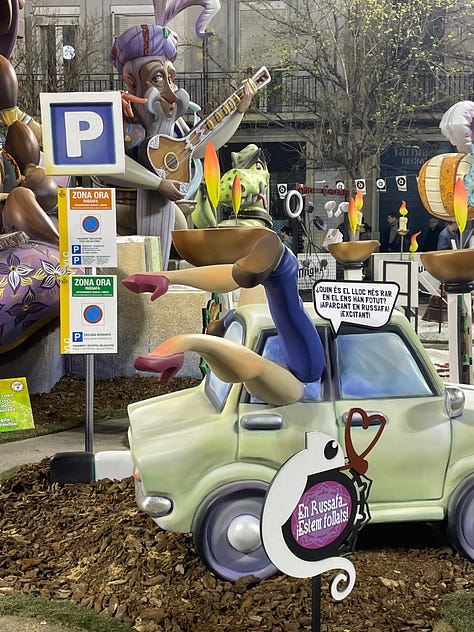
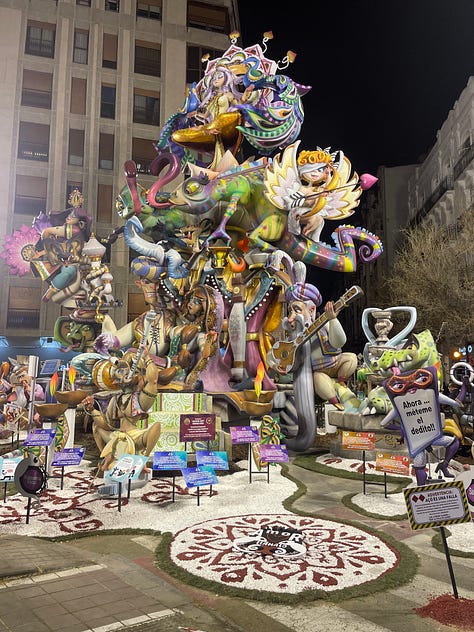
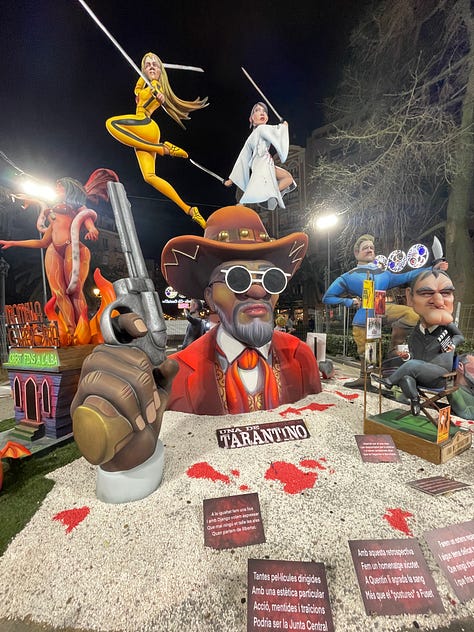
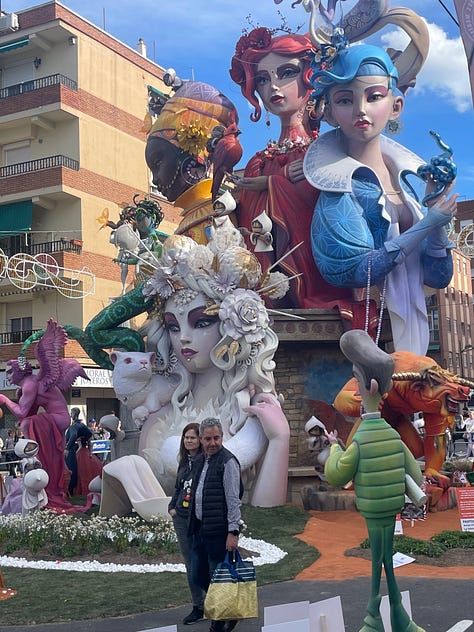
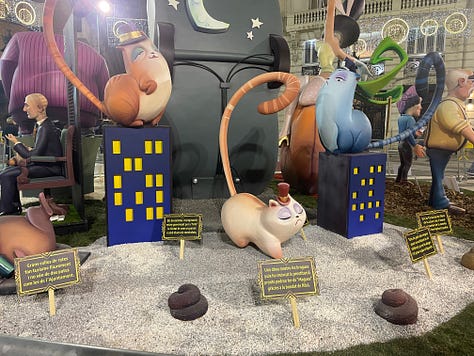
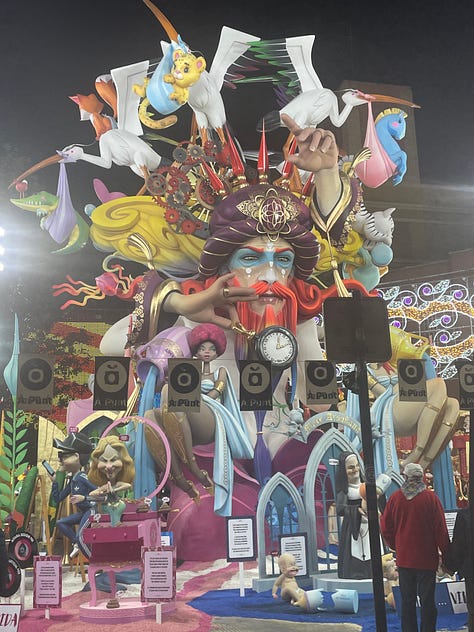
These sculptures are perhaps the most famous part of Fallas. They will feature a main sculpture, which can be inspired by a fable or classic joke – our tiny falla had the goose on the golden egg one year – or portray a more elaborate theme. Pirates, cowboys, dragons, Alice in Wonderland, queens and kings, and vikings show up every year. Some years are anniversaries – last year there were several Joaquin Sorolla-themed Fallas in recognition of the 100th anniversary of the Valencian painter’s death.
The more complex Fallas work their theme on three or four layers. There is the centerpiece, incorporating and outshining the theme. Then there are the complementary second level elements, your parrots and peg legged captains, your stagecoaches and bandits, and so on. Many of these add color to a given sculpture, though rarely nuance. They run heavy on stereotypes and racial insensitivity if not outright racist depictions. I mentioned petardos and crowds as Fallas’s blights, but large sculptures of, say, men with large buckteeth meant to signify Chinese people are more fundamentally problematic. It is also not all that surprising to find in Spain.
A more intentional, acceptable target of mockery and satire is found on the ground. These are the ninots, or dolls, the last category of figures. They tend to be based on real people, and to express some popular wisdom about them. Politicians, sports stars, local celebrities all feature, with captions spelled out in Valenciano8 verse. This year, they will no doubt mock the left-wing Spain party’s dalliances with Catalan nationalists to form a government, and also the new right-wing mayor in Valencia. Last year, there were a lot of complaints about parking in Ruzafa.
The Fallas home stretch
Back to our calendar. Officially, the sculpture fallas are installed on the streets overnight the 15th to the 16th, on the night of La Plantà (the planting). Practically, the biggest Fallas need a week or so of set up, which is why we start to see hints in the big crossroads of Ruzafa, in the hot spots in the Carmen (the old town in the center) around the 8th.
We can take la Plantà, though as the start of the last stretch of Fallas. If you want to plan on seeing the most of Fallas, this is when you want to come9. We still have our daily mascletàs, the sculptures are planted and open for visitors, and a few more events take place.
There are fireworks we can actually see – l’alba de las Fallas, the dawn of the Fallas, at midnight on the 16th, set off from the town hall square. Three consecutive castillos, midnight fireworks shows, on the following nights, set off from the Turia gardens city park, culminating in the Nit del Foc (night of fire).
There is La Ofrenda, the offering, the most solemn part of Fallas. Falleros march from four or five directions into the old city center and the Plaza de la Virgen, behind the Valencia Cathedral. They offer flowers, mostly red and white carnations, to a wooden structure. Attendants take those offerings and create a flower statue of Virgin Mary. This runs from March 17th-19th. I’ve gone to the plaza a couple times as it happens, and beyond the overwhelming crowds and the continued playing of the bands, the thing that sticks with me the most are the tears on falleros’ cheeks after they pay their tribute to the statue. It is almost diametrically opposed to my beliefs, and yet it is fascinating and moving.

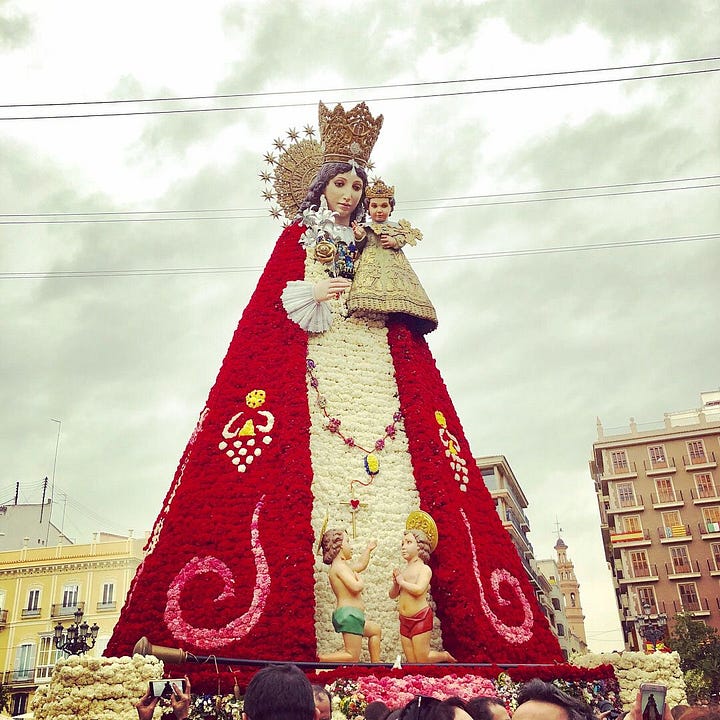
There is La Despertà, the wake-up call, another round of fireworks, but at 8 in the morning. In my memory this is a last day event, but I have a video of la despertà from March 16th, last year. Each of the last four days event, then. Similarly, local mascletàs are held in neighborhood fallas throughout the city on the 19th, and explosions cascade for about an hour before becoming more sporadic.
All this build-up leads to one final main event. I said there may be pagan roots to Fallas, and our primitive side comes out in the last act, La Cremà, the burning. At this point, in a steady progression on March 19th from 8pm to, officially, 11pm10, each neighborhood falla as well as the city administration oversee the burning of the sculpture fallas.
A Crema from preamble to ignition.
La Cremà has its own basic rhythm. First there is the gathering and, for the big fallas, the jostling to get a good sightline to the falla. Once the neighbors in charge are ready, one of two things happens. Either a band on site plays a more funereal march to mark the end of the festival, or the neighbors jump to step two. Step two is lighting a rope which runs 20 or more feet to the inner center of the falla. Attached to that elongated wick are fireworks that go off inside the falla, designed to ignite the whole thing on fire. The fire emerges from the center, the flames lick up the top of the sculpture, the crowd cheers, and then everybody watches the falla burn. Repeat this 300 or so times across the span of Valencia, along with whatever other towns and cities do this in the region, clean up all the ashes, and by the morning of the 20th, everything is more or less back to normal, clean, quiet, and a little hung over.
The Endurance Test of Fallas, and its Somber Backdrop
Fallas is a tiring festival, 19 days of build-up and noise and sensory overload. There are things about it I do not like, or could do without, or wish were better.
Fallas in 2024 has some added freight. Another ‘normal’ post-Covid Fallas should carry a celebratory air. But Valencia also just had a tragedy, and a particularly painful one in the context of Fallas. Last Thursday, two conjoined apartment towers went up in smoke, a 7th floor apartment fire igniting the entire building like so many Fallas, due to a synthetic aluminum material that was highly inflammable, as well as high winds and an unusually hot February day. 10 died and more than 400 lost their homes.
We don’t have an office to work in or regular avenues to swap gossip, so I can’t speak definitively. From what I have seen, though, I would be surprised if the fire slows down Fallas beyond postponing La Crida. There will be commemorations and homages, this is a great city tragedy and people care, but Fallas must go on. And I don’t mean to make any direct link between the controlled, traditional burns of Fallas and this tragedy; but it will be curious how people react to fire after the reminder of its destructive power.
There is something odd about Fallas. About spending all that money and effort on parties, sure, but also on these beautiful statues that are then burnt. All the smoke that goes into the air from La Crema and all the Mascletas. The noise pollution, the trampling on and drowning out of the natural environment for 19 days.
If we can zoom back in on the Crema itself, we can find beauty. Not in the statues at that point, but in the act of renewal. It is more meaningful to me, in its symbolism, than New Year’s Eve. We are all pagans and cavepeople in our DNA, in our primal roots, and the site of fire, defanged, is awe-inspiring.
Fallas is an exhausting festival, and I still love it. But, like so many things in our modern world, it becomes clearer every year that our rituals and fun come at a cost.
It is not a coincidence in that Saint Joseph is Jesus’s father. Father’s day is observed on this day in a smattering of European Catholic countries.
I’m not clear whether they actually ‘fashion’ their hair this way or just wear earpieces; this blog suggests they fashion everything but the earpieces, which are pre-sewn.
In 2020, Fallas was canceled midway through; In 2021 they were held September 1-5'; in 2022, Fallas was almost normal, but people were still feeling their way around.
This year’s Crida will take place on March 3rd, for reasons to be explained shortly.
“Excuse us, let the gentleman pass.”
There used to be a midnight light show staged in Ruzafa, but it has been canceled on account of overcrowding.
Favorite to the point that, when being interviewed on local TV after a mascletà, I waxed on about the music. “Fallas really rocks me” I said, in inappropriately slangy language and awkward grammar, my Spanish still quite limited. Amy was too embarrassed to speak much.
Valenciano is its own language, similar to Spanish. It is very close to Catalan.
If you don’t care about the burning itself, I would time a trip for somewhere between the 10th and 17th, where you can see all the Fallas and get the festive feel but also get out of town before the crowds overflow.
I.e. that’s how it’s listed in the calendar. In reality, cremàs can ignite as last as 3 or 4 in the morning, to spread out the firefighters on call to ensure nothing gets out of hand.




